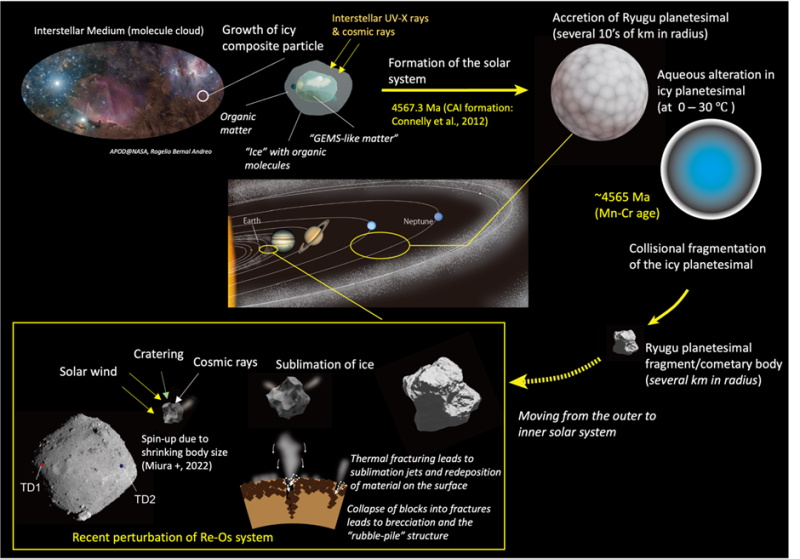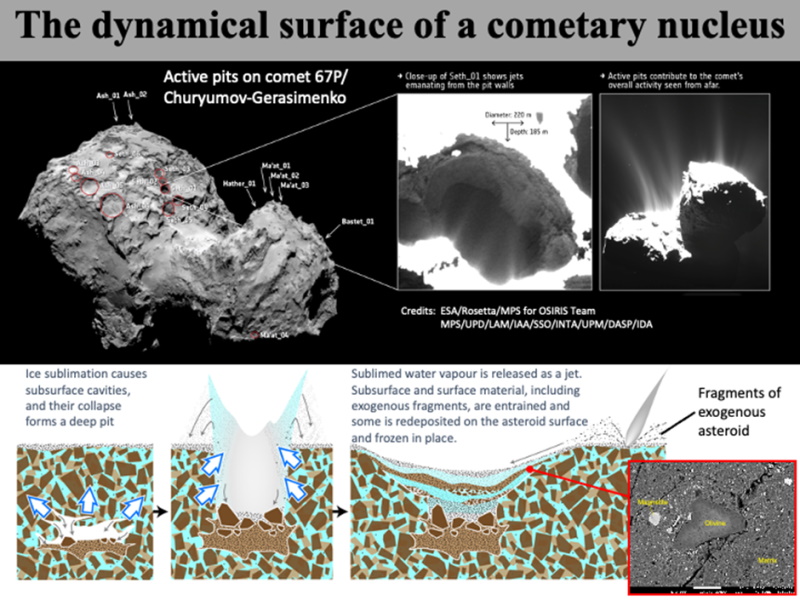Release Type: Research News
Headline: What happened before, during and after solar system formation? A recent study of the Asteroid Ryugu holds the answers!
Subheadline: A team of scientists undertake a comprehensive analysis of samples returned from the Japan Aerospace Exploration Agency’s Hayab#usa2 mission and provide invaluable insights into the formation and evolution of our solar system.
Summary
The Japan Aerospace Exploration Agency’s (JAXA) Hayabusa2 mission returned uncontaminated primitive asteroid samples to Earth. A comprehensive analysis of 16 particles from the asteroid Ryugu revealed many insights into the processes that operated before, during and after the formation of the solar system, with some still shaping the surface of the present-day asteroid. Elemental and isotopic data revealed that Ryugu contains the most primitive pre-solar nebular (an ancient disk of gas and dust surrounding what would become the Sun) material yet identified and that some organic materials may have been inherited from before the solar system formed. Among the organic materials identified were amino acids, which are the building blocks of the proteins that are in all living things on Earth. The discovery of protein forming amino acids in uncontaminated asteroid samples indicates that asteroids such as Ryugu may have seeded the Earth with the raw materials required for the origin of life. Furthermore, Ryugu samples provided both physical and chemical evidence that Ryugu originated from a large (at least several 10’s of km) icy body in outer solar system, which experienced aqueous alteration (complex chemical reactions involving liquid water). The icy body was then broken up to yield a comet-like fragment (several km in size). The fragment evolved through sublimation of ice to yield the dry porous asteroid observed today. Subsequently, space weathering, involving the bombardment of the asteroid by particles from the sun and distant stars, altered the surface materials, such as organic matter, to give materials with a distinct albedo (reflective properties), defining how the asteroid currently appears.
Full Text
Asteroids and comets represent the material that was left over after the formation of the planets that orbit the Sun. Such bodies would have initially formed in a vast disk of gas and dust (protosolar nebular) around what would eventually become the Sun (protosun) and thus can preserve clues about the processes that operated during this period of the Solar system. The protosolar nebular would have been spinning fastest towards its center and this would have concentrated much of the material within this region. Some of the material then began to fall onto the surface of the protosun, increasing its temperature. The higher temperature of the protosun would have led to an increased output of radiation, which could have caused photoevaporation (evaporation due to energy from light) of the material within the inner solar system. Later, as the inner solar system cooled, new material condensed with distinct compositions to what had been present before. Eventually such materials would stick together to produce large bodies (planetesimals) that would then break up from collisions, with some forming S-type asteroids. One S-type asteroid (Itokawa) was the target of the Hayabusa mission, the predecessor of Hayabusa2. The samples that were returned to Earth revealed a lot about such asteroids, including how their surfaces are affected by continuous small impacts and confirming identifications made through telescopes on Earth.
Haybusa2 targeted a very different type of asteroid, C-type, which unlike S-types preserve far more of the primitive outer solar system material, which was much less affected by heating from the protosun. Initial Earth based telescope and remote sensing information from the Hayabusa2 spacecraft suggested that Ryugu may contain organic matter and small amounts water (stuck to the surface of minerals or contained within their structure). However, C-type asteroids are incredibly hard to study using such methods, because they are very dark and the resulting data has very little information that can be used to identify specific materials. As such, the sample return represented a very important step in improving our understanding of C-type asteroids. Around 5.4 g of sample was returned to the Earth in December 2020 and the samples were initially studied at the Japan Aerospace Exploration Agency’s (JAXA) phase-1 curation facility at Sagamihara, Japan. Comprehensive geochemical analysis was begun in June 2021 once the samples had arrived at the phase-2 curation facility of the Pheasant Memorial Laboratory (PML), Institute for Planetary Materials, Okayama University, Japan.
Initially, the external and physical information of the samples was obtained (Figure 1), but shortly after the particles were cut open using a microtome equipped with a diamond knife. Inside, the particles revealed textures indicative of freeze-thawing and a fine-grained mass of different minerals, with some coarser-grained components being dispersed throughout (Figure 2). The majority of the minerals were hydrous silicates called phyllosilicates (clay), which formed through chemical reactions involving non-hydrous silicate minerals and liquid water (aqueous alteration). Together with the freeze-thaw textures, the evidence indicated that the samples had experienced both liquid and frozen water in the past.
The aqueous alteration (Figure 3) was found to have peaked before ~2.6 Myr after the formation of the solar system, through analysis of manganese and chromium within magnetite (iron oxide) and dolomite (calcium-magnesium carbonate) minerals. This means that the materials from Ryugu experienced liquid water very early in the Solar System’s history and the heat that melted the ice would have been supplied from radioactive elements (Figure 4) that only survive for a relatively short period of time (almost all would be gone after 5 Myr). After much of the radioactive elements had decayed the body would cool and freeze again. Ryugu also contains chromium, calcium and oxygen isotopes that indicate it preserved the most primitive source of materials from the protosolar nebular. Furthermore, organic materials from Ryugu record primitive isotopic signatures suggestive of their formation within the interstellar medium (the region of space between solar systems) or outer protosolar nebular. Together with the abundant water and the lack of any inner solar system material or signatures, the above findings suggest that the material within Ryugu was stuck together (accreted) and aqueously altered very early in the outer solar system (Figure 5).
However, to form liquid water, from the heating of a rocky-icy body by radioactive decay, requires the body to be at least several 10’s of km in size. Accordingly, Ryugu must have originally been a part of a much bigger body, termed a planetesimal. Icy planetesimals are thought to be the source of comets, which can be formed by their collisional break up. If the planetesimal precursor of Ryugu was impacted after it had re-frozen, then a comet preserving many of the original textures and physical and chemical properties of the planetesimal could be produced. As a comet the fragment would have needed to move from the outer to inner solar system by some dynamical pathway, involving the interactions of the planets. Once in the inner solar system Ryugu would have then undergone significant sublimation (transition of solid ice to gas). Modelling in a previous study indicated that the sublimation could increase the rate at which Ryugu spins and lead to its distinctive spinning top shape. The sublimation could have also led to the formation of water vapor jets (as seen on the comet 67P) that would have redeposited subsurface material onto the surface and frozen it in place (Figure 6).
Moreover, the jets may be able to explain some interesting differences between the sampling sites where the Ryugu samples were obtained. The Hayabusa2 mission sampled material from the very surface at touch down site 1 (TD1) and most likely subsurface material from an artificial impact crater at touch down site 2 (TD2). Some of the TD1 samples show elemental fractionation beyond the mm scale and scattered B and Be abundances. However, all TD2 samples record elemental abundances similar to CI chondrites (a type of meteorite with elemental abundances similar to the Sun) and show no evidence of elemental fractionation over the mm scale. One explanation is that the TD1 site records the material entrained in a jet, brought to the surface of the comet-like fragment from many distinct regions of the subsurface and thus represents a wide variety of compositions. Meanwhile, the TD2 samples may represent material sourced from one part of Ryugu and as such have a more uniform composition.
After complete sublimation of the ice at the surface of Ryugu, a low density and highly porous rocky asteroid was formed. While water related processes ceased, space weathering began. The surface of Ryugu was bombarded over time by large quantities of energetic particles from solar wind and cosmic rays from the sun and distant stars. The particles modified the materials on the surface of Ryugu, causing the organic matter to alter in terms of its structure. The effects of such a process were more obvious in TD1 particles from the surface of Ryugu when compared to those from TD2, which had likely been brought to the surface during the creation of an artificial impact crater. As such, space weathering is a process that still shapes the surfaces of asteroids today and will continue to do so in the future.
Despite the effects of space weathering, which act to alter and destroy the information contained within organic matter, primitive organic materials were also detected by the comprehensive geochemical analysis of the Ryugu samples. Amino acids, such as those found within the proteins of every living organism on Earth, were detected in a Ryugu particle. The discovery of protein forming amino acids is important, because Ryugu has not been exposed to the Earth’s biosphere, like meteorites, and as such their detection proves that at least some of the building blocks of life on Earth could have been formed in space environments. Hypotheses concerning the origin of life, such as those involving hydrothermal activity, require sources of amino acids, with meteorites and asteroids like Ryugu representing strong candidates due to their inventory of amino acids and because such material would have been readily delivered to the surface of the early Earth. Additionally, the isotopic characteristics of the Ryugu samples suggest that Ryugu-like material could have supplied the Earth with its water, another resource essential for the origin and sustainment of life on Earth.
In conjunction the findings reported by the study provide invaluable insights into the processes that have affected the most primitive asteroid sampled by human kind. Such insights have already begun to change our understanding of the events that occurred from before the solar system and up until the current day. Future work on the Ryugu samples will no doubt continue to advance our knowledge of the solar system and beyond.
Website : Pheasant Memorial Laboratory

